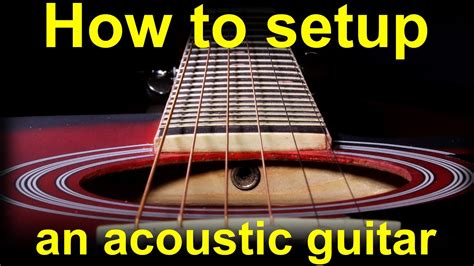Acoustic Guitar Setup Secrets: The Truss Rod Revealed
For acoustic guitarists, achieving the perfect playing experience hinges on a properly set-up instrument. While many aspects contribute to playability, the truss rod stands as a critical component often misunderstood. This guide delves into the mysteries of the acoustic guitar truss rod, explaining its function, adjustment procedures, and how understanding it can unlock the secrets to a superior playing experience.
What is a Truss Rod and What Does it Do?
The truss rod is a steel rod running along the length of the guitar neck, inside the neck itself. Its primary function is to counteract the tension created by the strings. When strings are tightened, they exert a significant amount of downward pressure on the neck, potentially causing it to bow or warp. The truss rod counteracts this, enabling you to adjust the neck's relief – the slight curve or concavity – for optimal playing comfort and intonation.
How Does the Truss Rod Affect Playability?
A properly adjusted truss rod ensures the neck maintains the ideal amount of relief. Too much relief (back bow) makes the action (string height) high, making the guitar difficult to play and producing a buzzing sound. Conversely, too little relief (forward bow) can cause fretting difficulties and a choked tone. The sweet spot is a slight concave curve, often described as a "low relief" for most acoustic guitars.
How to Tell if Your Acoustic Guitar Needs a Truss Rod Adjustment?
Several signs indicate your guitar requires a truss rod adjustment:
- High Action: Strings feel excessively high above the frets, making playing uncomfortable and potentially causing fret buzz.
- Fret Buzz: Strings buzz against the frets even when played lightly.
- Neck Bow: Visually inspect your neck. A pronounced back bow (convex) or forward bow (concave) indicates a need for adjustment. Place a straight edge across the frets (ideally the 6th fret and 14th fret) to check for excessive bow.
- Intonation Problems: Despite string adjustments, the guitar consistently goes out of tune, particularly in the higher registers. This could be due to neck relief affecting string tension along the neck.
What Happens if You Adjust the Truss Rod Incorrectly?
Improper truss rod adjustment can severely damage your guitar neck. Over-tightening can crack the neck, while over-loosening can lead to significant warping. If you're not comfortable with this procedure, seeking the expertise of a professional luthier is crucial.
Can I Adjust the Truss Rod Myself?
While many online resources provide guidance, adjusting the truss rod yourself carries risks. It's a delicate process that requires careful attention and understanding. For beginners, it’s strongly advised to consult a qualified luthier. Improper adjustment can render your guitar unplayable and costly to repair.
What Tools Do I Need to Adjust the Truss Rod?
The specific tools depend on your guitar's truss rod adjustment mechanism. Most often, you'll need either a small Allen wrench (for standard hex-key adjustments) or a specialized truss rod wrench for less common designs. Never attempt to use an unsuitable tool.
How Often Should I Check My Truss Rod?
Regular checks, at least once or twice a year, or more frequently if you live in a region with significant humidity fluctuations, are recommended. Climate change can significantly impact the wood of your guitar's neck.
How Can I Prevent Truss Rod Problems?
Proper care and storage are crucial in preventing truss rod issues. Maintaining a stable environment with consistent humidity levels (ideally around 45-55%) helps prevent drastic wood expansion and contraction, minimizing stress on the neck. Keep your guitar in its case when not in use to protect it from extreme temperature and humidity.
This guide provides a foundation for understanding your acoustic guitar's truss rod. While the information empowers you to take better care of your instrument, remember that professional assistance is always the safest approach when dealing with adjustments. The subtle nuances of wood, construction, and individual guitar setup will always require an expert eye for the perfect balance. The reward, however, is a guitar that sings!

